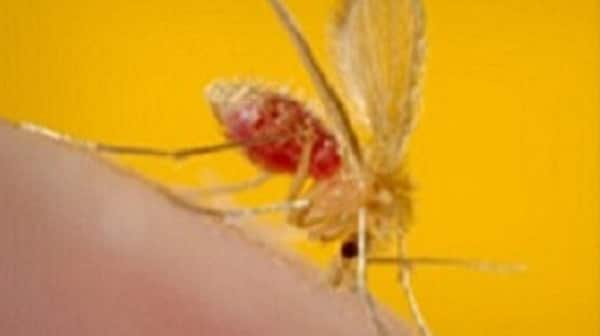Key points
- Leishmaniasis is a parasitic disease caused by infection with Leishmania parasites, which are spread by the bite of infected sand flies.
- A parasite is an organism (a living thing) that lives on or inside another organism.
- Although different forms of leishmaniasis affect people in different ways, the most common type causes skin sores.
- See your healthcare provider if you think you have leishmaniasis.

Overview
Leishmaniasis is a parasitic disease caused by an infection with Leishmania parasites, which are spread by the bite of infected sand flies. Leishmaniasis is a neglected tropical disease (NTD).
Forms
There are several different forms of leishmaniasis in people:
- Cutaneous leishmaniasis (CL): the most common form, which causes skin sores.
- Mucosal leishmaniasis (ML): a severe type of CL that can cause sores in the nose, mouth, or throat. ML can be life threatening.
- Visceral leishmaniasis (VL): this is a less common form, especially in the United States, which affects internal organs. If not treated, severe cases of VL can be deadly.
Signs and symptoms
Signs and symptoms can vary based on the form of leishmaniasis. People may or may not experience signs and symptoms.
Cutaneous leishmaniasis (CL)
Those who develop symptoms have one or more skin sores, which can change in size and appearance over time. The skin sores usually develop within a few weeks or months of the sand fly bite. The sores are often painless.
Mucosal leishmaniasis (ML)
ML is a form of leishmaniasis that affects the mucous membranes (most commonly the nose, but also the mouth and throat). ML can be a consequence of infection with some of the types of parasites that cause CL in parts of Central and South America and, rarely, other places.
Visceral leishmaniasis (VL)
VL is another form of leishmaniasis caused by a small number of Leishmania species. People with VL may develop fever, generalized illness, and anemia (low red blood cells). VL often goes on to affect internal organs (especially the spleen, liver, and bone marrow) and can be life threatening. People with VL usually become sick within months (though it can be years) of the sand fly bite. If untreated, VL is typically deadly.
Who is at risk
Anyone who lives in or travels to an area where Leishmania parasites occur and is bitten by an infected sand fly is at risk for leishmaniasis. It is usually more common in rural areas but can also occur in the outskirts of some cities. Dusk to dawn is the time when people are most likely to be bitten.
Leishmaniasis occurs in parts of approximately 90 countries, usually in tropical or subtropical climates.
Leishmaniasis in the United States
Most cases of leishmaniasis that are diagnosed in the US are in people who were infected while traveling or living in other countries.
Occasionally, people have had locally acquired CL, especially in Texas and rarely other states (e.g., Oklahoma and Arizona). There have been no known cases of acquired VL in the US.
How it spreads
The main way people get infected with leishmaniasis is through the bite of an infected female sand fly. People may not notice the bites because sand flies are silent, very small, and the bites can be painless for many people. On average, sand flies that transmit the parasite are only about one fourth the size of mosquitoes (sometimes even smaller).
Sand flies are usually most active at twilight, evening, and nighttime hours (dusk to dawn).
Some species of Leishmania parasites can also be spread via contaminated needles (needle sharing) or blood transfusions. There have also been reports of congenital transmission (mother passing an infection to her baby during pregnancy or at birth).
Prevention
There are no vaccines or drugs to prevent leishmaniasis. The best way to prevent infection is to protect yourself from sand fly bites through preventive measures.
Even if you already had leishmaniasis, it is possible to get it again. Therefore, it is important to follow preventive measures.
Diagnosis
If you have traveled or lived in a part of the world where leishmaniasis occurs and have symptoms, talk to your healthcare provider.
CDC staff can advise your healthcare provider and help with laboratory testing for leishmaniasis. Your healthcare provider will test tissue samples from skin sores (for CL) or from bone marrow (for VL) to examine for diagnosis. Blood tests can be helpful for VL.
Treatment and recovery
CDC staff can advise your healthcare provider on whether your case of leishmaniasis should be treated, and if so, with what type of treatment.
Cutaneous leishmaniasis (CL)
Different types of treatment are available for CL and the choice of treatment depends on multiple factors, including the species of Leishmania parasite involved. In some cases, skin sores from CL might heal on their own without treatment depending on the species involved. Leishmania skin sores can take months to years to heal and the sores can leave significant scars.
Mucosal leishmaniasis (ML)
For the Leishmania species that cause ML, it is important to have proper treatment in order to prevent mucosal tissue destruction in the nose, mouth, or throat. Without treatment, ML can be life threatening if it affects the throat.
Visceral leishmaniasis (VL)
It is important to recognize and treat VL early. If not treated, severe (advanced) cases of VL are typically deadly. In people with compromised immune systems (e.g., HIV, malnutrition), VL can be difficult to treat.
